Archie McPhee is a store based out of Seattle, Washington known for quirky and unusual novelty toys and kitsch gifts. They also have an online store. Among many of the products sold by Archie McPhee, which can include anything from rubber chickens to bacon-scented air freshener, to finger puppets, are a decent selection of toy animals. Today we will be looking at a set of miniature garden birds, which were produced specifically for Archie McPhee in 2023. The set consists of eight species of passerines, seven of which are native to North America and one which is native to Europe and Western Asia. The figures are small, similar in scale to many TOOB/tube figures. They are smaller than than the Backyard Birds TOOB figures by Safari Ltd. (but then again, those figures are more comparable in size to Wings of the World models), and are more in line with those in Safari’s most recent TOOBs over the last few years. The legs are a but pliable and prone to warping (but so far, none of them have obvious stability issues). Because there are eight figures, and they are all is the same upright static pose, I am only going to feature one pic per species.
For starters, here are pics of the front and back of the box:

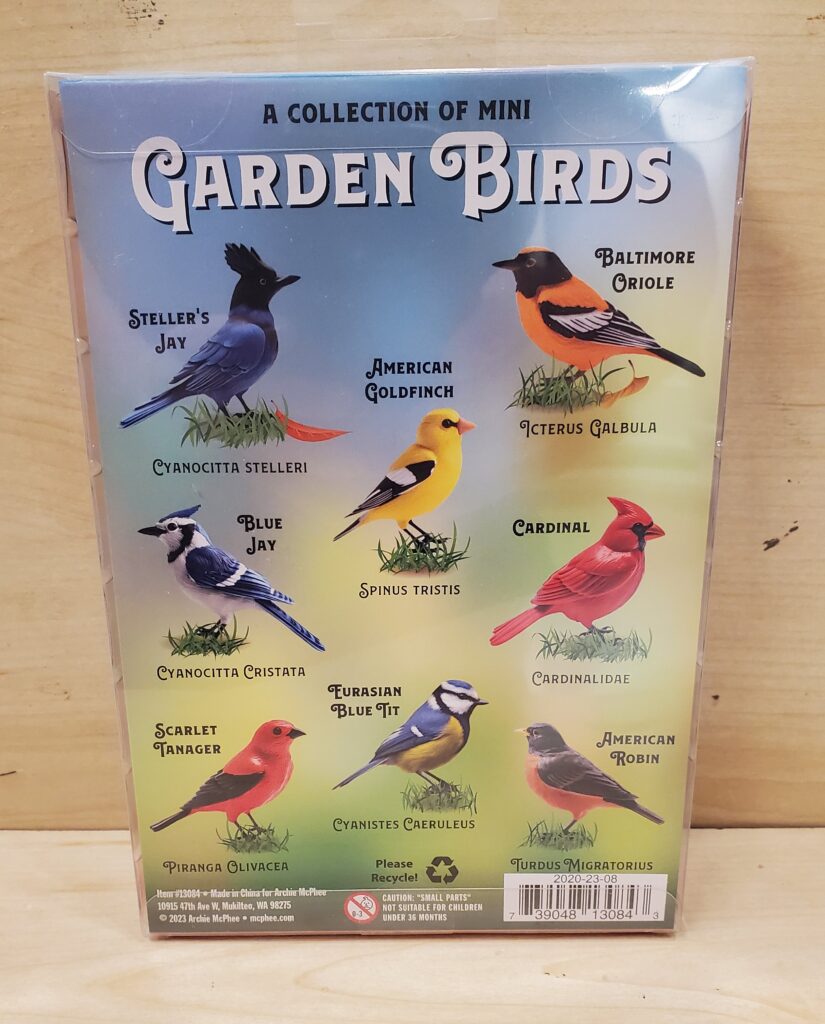
Steller’s Jay (Cyanocitta stelleri)
Steller’s Jay is a corvid that occurs primarily in montane coniferous forests throughout western North America, from southern Alaska to Nicaragua. This was an exciting acquisition for me, as Steller’s Jays occur in the canyon behind my apartment where I bird frequently. Steller’s Jay, like other corvids, is known to produce a wide range of vocalizations and are known to mimic various raptors. I have often heard them mimicking Red-tailed Hawks in my area. The jays will even respond to the calls of raptors to assess risk. The figure has a body length of approximately 4.5 cm for a scale of 1:6.7-1:7.5. To my knowledge this figure is unique for this species.
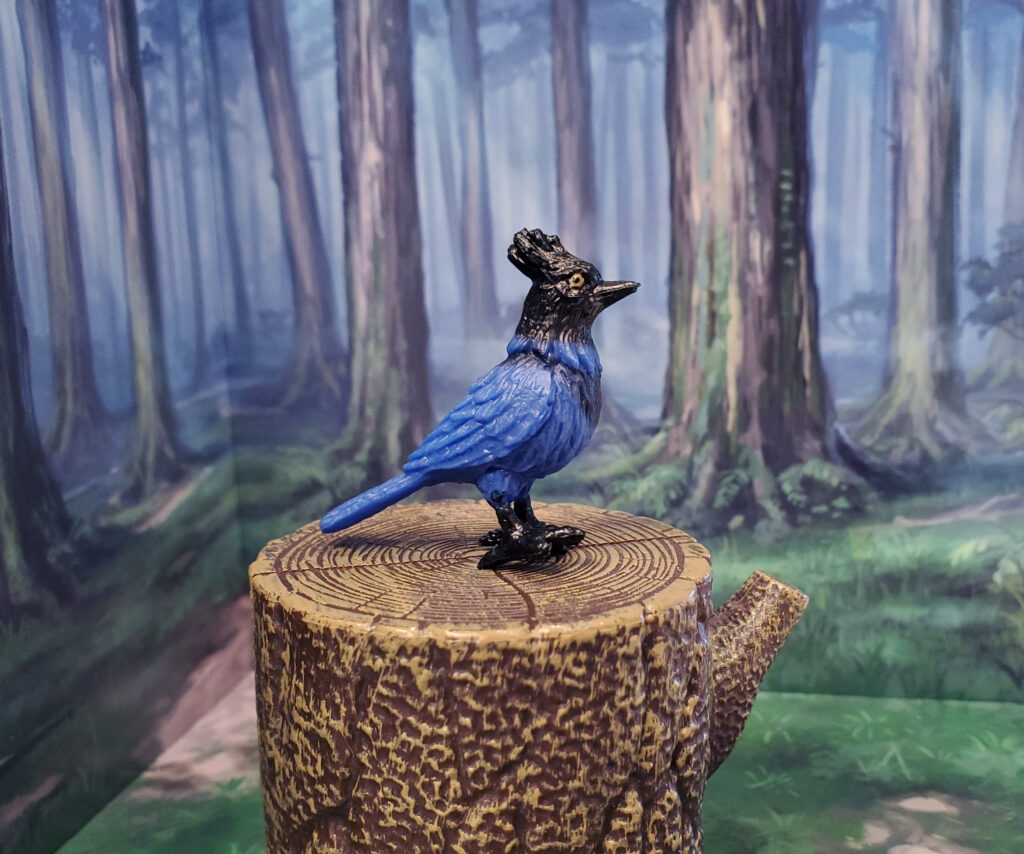
Baltimore Oriole (Icterus galbula)
The Baltimore Oriole is a common and familiar backyard bird in northeastern North America. It winters in Florida, the Caribbean, and Central and northern South America. They forage for fruit and insects and may be attracted to one’s yard using fruit or oriole-specific feeders. This species was also featured in Safari’s Backyard Birds TOOB. The color on this Archie McPhee figure is perplexing. On one hand, it possesses the white wing bars, something the Safari figure lacks, but there is orange on the back and an orange cap. With the exception of the orange cap, it more closely resembles the Mexican species, Audubon’s Oriole (Icterus graduacauda). I am still on the fence about which figure to retain in my collection. I like the white wing bars seen here, but the base color is more accurate in the Safari figure. I normally don’t like to alter figures, but with a little darkening of the cap and back, this can easily become a very nice representative of its intended species! Body length comes to approximately 4.3 cm for a scale of 1:4-1:5.1.
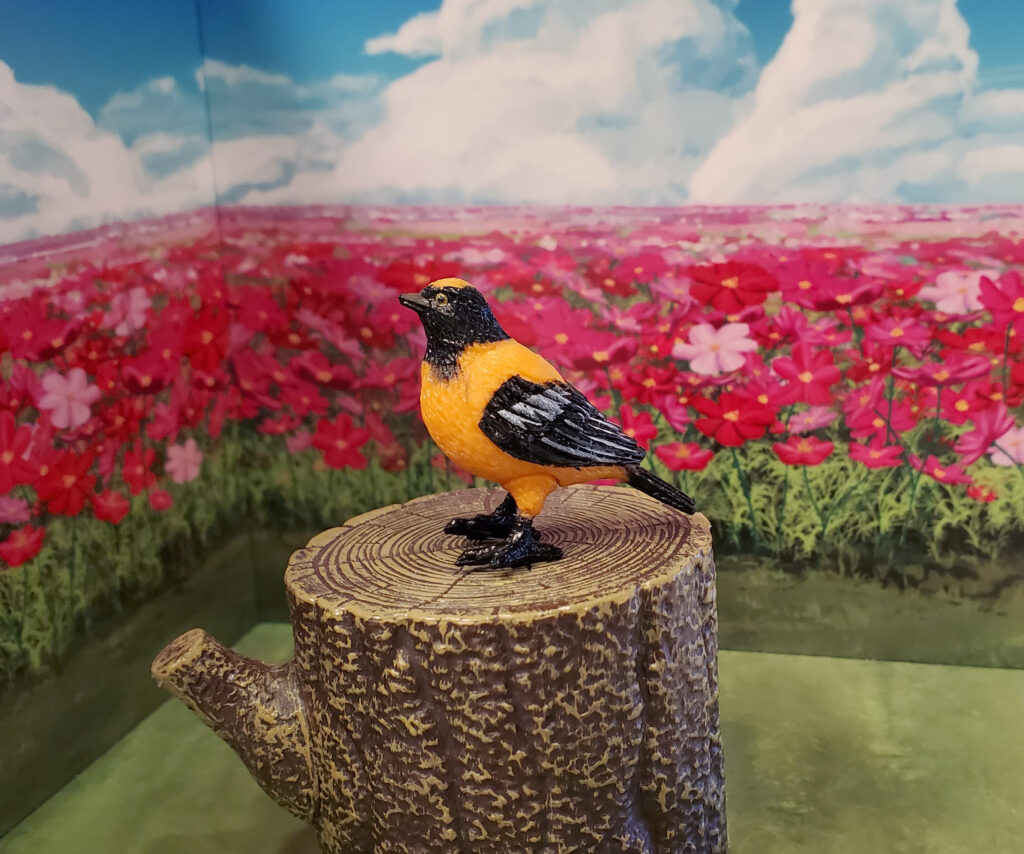
Northern Cardinal (Cardinalis cardinalis)
The Northern Cardinal is a bird that needs little to no introduction to birders, biologists, and nature enthusiasts in general in North America. It is common in the East to the Southwest, south to the Yucatan Peninsula. It is absent in the Rocky Mountain region, West Coast, and Pacific Northwest. It is a common visitor to feeders, the state bird of seven US states, and the mascot for numerous sports teams in the United States. This is a very well-done little figure, with a body length of roughly 4.0 cm, it comes to a scale of 1:5.3-1:5.9. I think for my synoptic collection, I’ll retain the Safari TOOB figure, however.

Scarlet Tanager (Piranga olivacea)
The Scarlet Tanager is a colorful little cousin of the Northern Cardinal. It breeds in northeastern USA and adjacent Canada and winters as far south as South America. It prefers oak woodlands, but can also be found in suburban parks, gardens, and cemeteries where it forages for insects and fruit. There is at least one other figure of this species to my knowledge, a monochromatic model produced by Marx in the 1960. The figure has a body length of approximately 4.0 cm for a scale of 1:1-1:4.8. One minor error is that the beak is painted black when it should be pale. Otherwise, it’s a find rendition and I plan to retain it for my synoptic collection for sure!
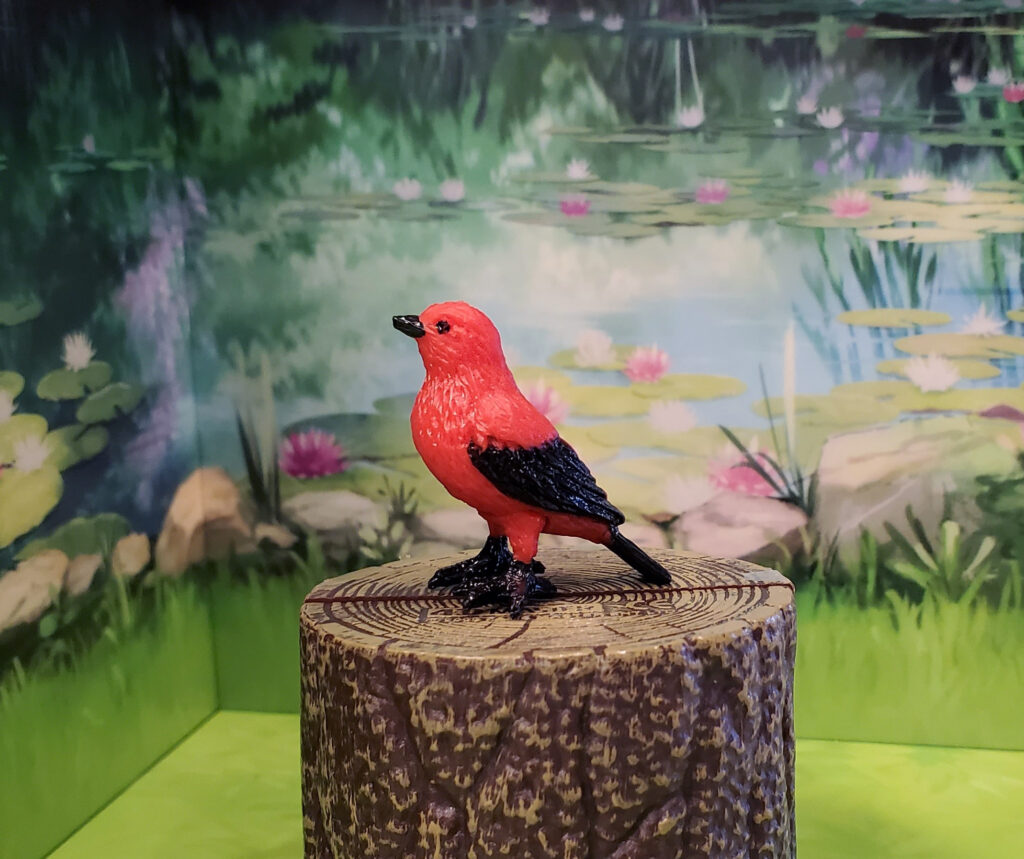
American Goldfinch (Spinus tristis)
Next up is another familiar backyard feeder bird, the American Goldfinch. It breeds in northern North America, but can be found during migration as far south as Mexico. Where I live, it occurs year-round, but it’s the less common of the goldfinches, as where I live we see the Lesser Goldfinch (S. psaltria) more commonly. The figure is painted bright yellow with black wings accented with white wingbars. It’s lacking the characteristic black cap of the male American Goldfinch, however. One could argue it is a breeding female; while usually not this bright yellow, some females do brighten up during the summer. The figure has a body length of approximately 4.0 cm for a scale of 1:2.8-1:3.5. Marx made a golfinch in the 1960s, but didn’t indicate which species and since it’s a monochromatic figure, one cannot use color to say for sure which species it is.

American Robin (Turdus migratorius)
The American Robin is another familiar bird throughout all of North America. While it occurs year-round in many places, populations shift, so birds seen in a given area are not necessarily the same individual birds all year. This is another species that was featured in Safari’s Backyard Birds TOOB. I prefer the Safari version when it comes to the robin, because of its darker head. However, one could make the case that this Archie McPhee robin is a female or possibly juvenile specimen. The figure has a body length of about 4.5 cm for a scale of 1:5-1:6.2, so it scales smaller than the Safari version.
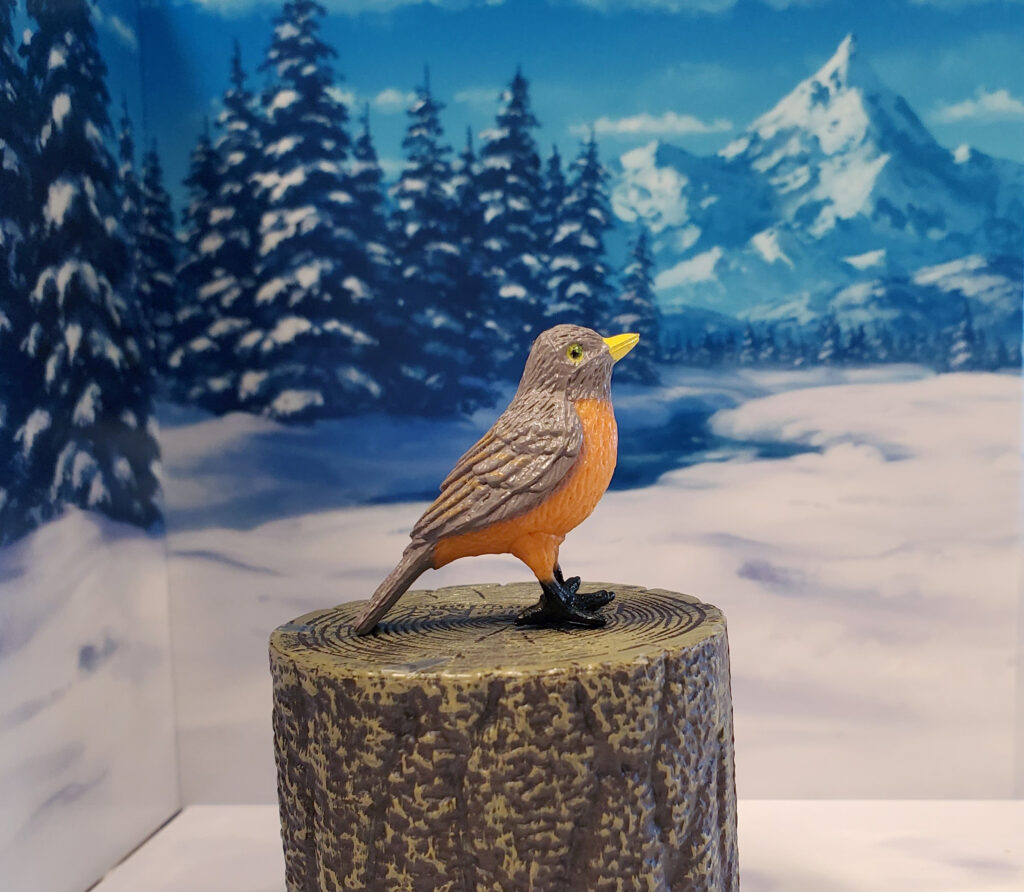
Blue Jay (Cyanocitta cristata)
Our next bird is the last of the Nearctic species in the set, the Blue Jay. This species is very common throughout eastern North America, with occasional vagrants in the Rocky Mountain region. The Blue Jay is a loud, bold, and aggressive corvid, and has no fear chasing raptors and owls away from its nests and territories. Like other corvids, it’s also considered a very intelligent bird. The figure measures approximately 4.5 cm for a scale of 1:4.9-1:1:6.7. I have to admit, I like this version more than the Safari TOOB version. I prefer the upright position of the crest and I like the colors better, as wingbars are present. I think for this species, this figure will replace Safari’s in my synoptic collection.
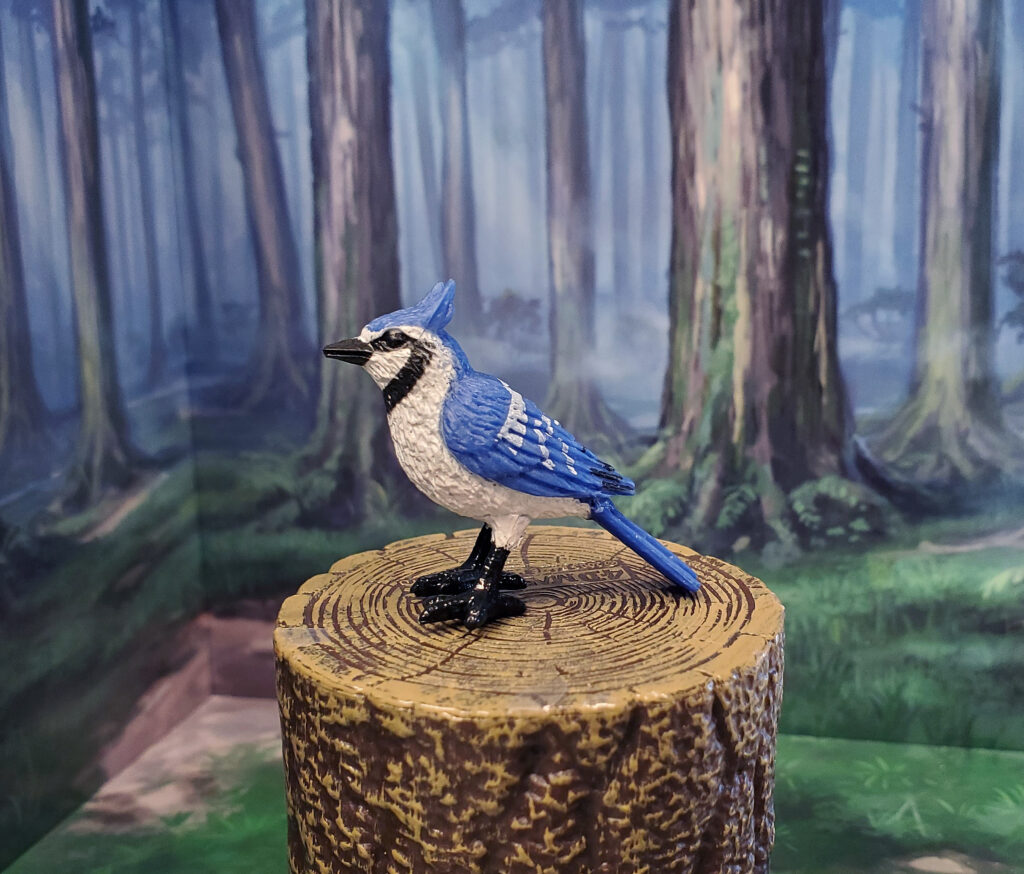
Eurasian Blue Tit (Cyanistes caeruleus)
Last up is a rather peculiar addition to the collection, the Eurasian Blue Tit. I say peculiar because it’s the only species in the set that is not native to the Nearctic. It lives in Europe and western Asia. There are occasional rare vagrants to North America, however. At the time of this writing, there are at least three records of it in North America on eBird around the Great Lakes region. In its native range, it is common in woodlands, parks, gardens, and hedges in farmland, and will visit feeders. Despite appearing geographically out of place with the rest of the models in this set, it’s a fine little figure that captures all of the hallmark features of a Eurasian Blue Tit. K&M International produced this species for their European Garden Nature Tube in the Wild Republic line, but honestly I like this Archie McPhee version a lot better. I don’t have the K&M figure, and now I see no reason to pursue it! The little figure is the smallest in the set and measures approximately 3.7 cm for a scale of 1:3.2.
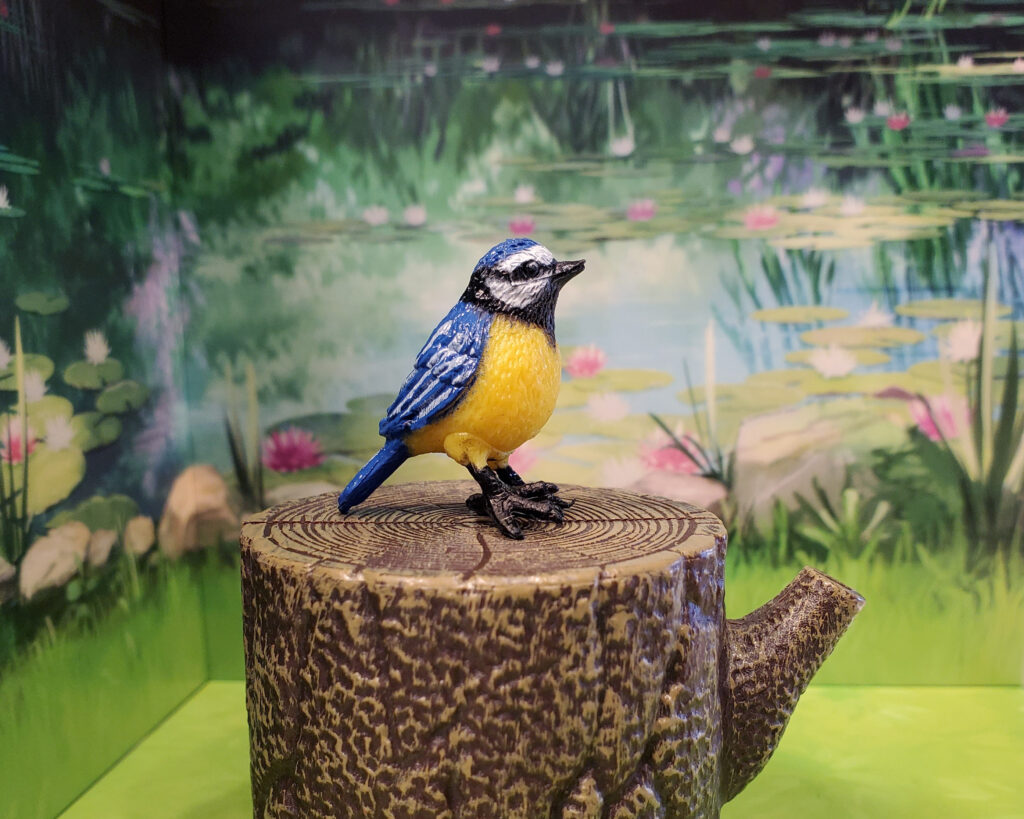
Overall this is a fun set of birds and comes recommended to bird specialists and collectors of interesting taxa. The set retails for about $15 on the Archie McPhee website (which is less than $2 a bird!).
Bird is the Word:
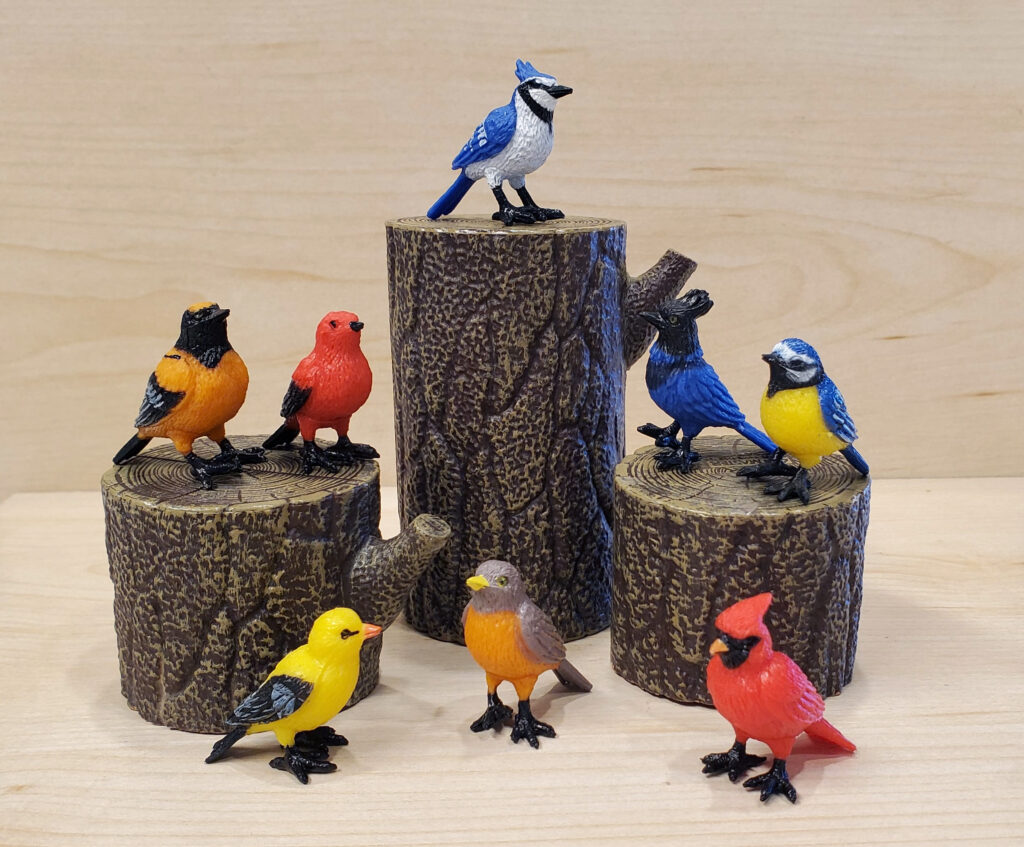
Disclaimer: links to Ebay and Amazon on the AnimalToyBlog are affiliate links, so we make a small commission if you use them. Thanks for supporting us!




These are better than I would have expected them to be. I especially like the jays. If I get this set I’ll have no qualms with fixing some of the color inaccuracies. Thanks for bringing this set to my attention!
Thanks for introduicing this set to me! I’ve managed to obtain it and I’m very happy with the bird figures! I also discovered Archie McPhee does crow figures, I’ve obtained some which I’m very happy with too.